 Side welding shop
Side welding shop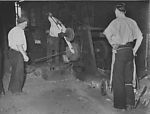 Starting a bend on a side welded link
Starting a bend on a side welded link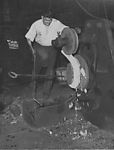 Finishing a bend on a side welded link
Finishing a bend on a side welded link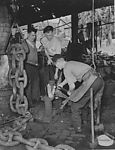 Using the opener
Using the opener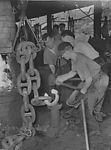 Closing with the Johnny
Closing with the Johnny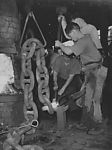 Making the first half weld with the Johnny and squabber
Making the first half weld with the Johnny and squabber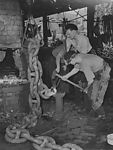 Runnering the weld
Runnering the weld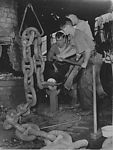 Setting the stud
Setting the stud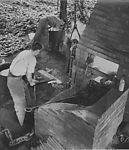 Cranking
Cranking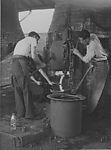 Knocking down
Knocking down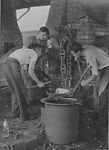 Scarfing
Scarfing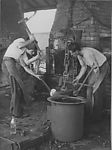 Laying over
Laying over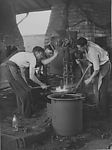 Welding
Welding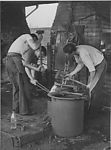 Dollying
Dollying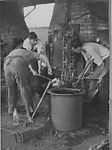 Setting the stud
Setting the stud A. Ewart Chapman painting.
A. Ewart Chapman painting.

Heavy chains made from 1in (25mm) diameter rod upwards, involved a team of men consisting of a chainmaker and several strikers. The number of strikers needed depended on the size of chain being made, from one striker for 1in chain, to three for the heaviest cable chains. The strikers were not employed by the factory, but by the chainmaker, who chose his own men and set the hours to be worked. Payment was by results, and the chainmaker tried to build a team of men he could depend on to work at his rate and in his manner. This method of subcontracting was called the “butty” system, and the chainmaking industry was among the last to use it.
Chains made from rod of between 1in and 2in diameter was a two man job, and was usually end welded, so the join in each link was at the end of the link, where the next link would pull against it. Rods of wrought iron would be cut to length on a shear and often stored close to the hearth to pre-heat. A rod was taken and placed in the fire and brought to welding heat, (between 1300 and 1400 degrees celsius) after which it was either placed in a bender and bent, or cranked with tongs and knocked down to form a “U” shape. Reheating in the fire followed and it was then threaded through the previous link. Each end was scarfed (flattened) and the scarfed ends placed over each other. More re-heating followed, and then the chainmaker welded or “shut” the scarf on the face of the anvil using a little clean sand as flux, used to clear impurities from the iron. The weld is finished on the point of the anvil by bringing the dolly, a tool with a curvature the same as the rod being used, down onto the link, and hammering it to make the rod return to its original size and shape.
Chain of 2in diameter rod upwards was usually side welded so the join was not where the next link would pull against it. When the bar was cut to length on the shears, the ends were cut at an angle of about 30 degrees to the centre line of the bar, so that each end of the link is ready scarfed for welding. After bringing to red heat in a furnace, the straight links were bent on a bending machine and returned to the furnace. Using a hook, the link was dragged to the hearth, seized with tongs, and lifted onto a stake mounted in the ground with a recess at the top the size of the bar being used. A sledge hammer, with a wedge-shaped head, was used to separate the two ends, an operation known as “opening”. The link was then returned to the fire to be brought back to welding heat. Using tongs, the link was withdrawn and held over the stake, so that the top half of the joint could be welded with the “Johnny" hammer, a two handled hammer. Three handled hammers, known as “Monday” hammers, were used for the largest of chain. A hollow faced tool called a “squabber” was held against the joint and struck to smooth the joint, again sand being used as a flux. The link was then returned to the fire to be brought back to welding temperature, and then removed so that the other side of the weld could be completed in the same manner. A tool called a “runner” was used like the squabber to remove hammer marks.
Chain cables were made in lenghts of 15 fathoms (27.4 metres), and each link was fitted with a stud to stop the cable becoming tangled, when stored in a ship’s locker. Also, if the chain was subjected to a great strain, there was a tendency for it to stretch and the two sides of the link close inwards, trapping the next link on each side. The studs were fitted as the last part of the process, welding not being required, as they were made of cast iron and held in place by virtue of the recess in each end. The stud would be held in place in the link by a member of the team, while another member hammered the long side of the link onto the stud.
A single link could weigh as much as 1cwt (50.8kgs), and the average weight for a hammer was 13kgs (27 pounds). The skill of the team would be to minimise handling and movement, so that energy was saved for the heavy lifting. For all the types of chain, methods varied from factory to factory and from chainmaker to chainmaker. The number of links a chainmaker could make depended on his skill, the size and quality of the iron and the quality of the fuel.
Rollover the captions in the box to see the available images in thumbnail format, click the caption to see the full-size image
| Reference: | 669 |
| Keywords: | |
| Archive Ref: | K. Gale Lib 1994/013/1250 |
| Updated: | Thu 22 Mar 2007 - 1 |
| Interpretation written by | Louis Howe |
| Author's organisation | Curatorial |
| Organisation's website |